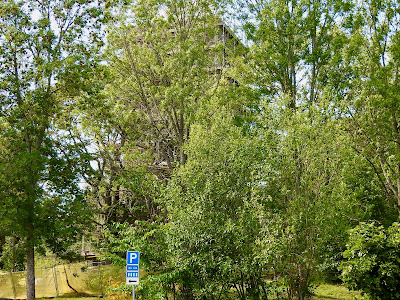目次 / Contents
1) 日帰旅行 / One Day Trip
2) 聖ピーター教会遺跡 / St. Peter's Church Ruins / St Per's Kyrkoruin
3) 家々 / Houses
1) 日帰旅行 / One Day Trip
私と夫Rは、ストックホルム市内から、スウェーデンで最古の町と言われるシグトゥーナへ日帰り旅行をしました。
支配する側からすると、'1人の王と1人の神'という体制は人々を統制しやすいですもんね。
北欧では、北欧神話の神々が信じられていて、中でもスウェーデンは最も遅くまで、キリスト教からすると異教の神々(北欧神話の神々)が影響していました。
私の個人的趣向からすると、北欧神話の神々がスウェーデンを、北欧を魅力的な地域にしているのですが...。
エリク6世 、彼の息子のオーロフ王 / オーロフ・シェートコヌング /
Olof Skötkonung / King Orof (? - 1022 / 在位:994頃 - 1022頃)
によって、シグトゥーナが、スウェーデンが、キリスト教に導きました。
中世時代には、シグトゥーナには、ギルド商会と裕福な町民によって7つの大きな石造りの教会が建てられました。
現在では、聖オーロフ教会遺跡 (地図 5)、
聖ローランス教会遺跡 (地図 6)、
聖ピーター教会遺跡 (地図 8)
の3つの遺跡が残っています。
聖ローランス教会遺跡 (地図 6)、
聖ピーター教会遺跡 (地図 8)
の3つの遺跡が残っています。
聖オーロフ教会遺跡については下記。
聖ローランス教会遺跡については下記。
シグトゥーナ は、ヴァイキング時代 (Viking Age / 793 - 1066) から、中世時代の1200年頃まで100年以上に渡って栄えました。
シグトゥーナには、他のどこよりも、ルーン石碑が多く保存され、町の散策マップにも記載されています。
私達は、ルーン石碑を追って、町を歩きました。
 |
散策マップ
5 : 聖オーロフ教会遺跡
6. 聖ローランス教会遺跡
8.聖ピーター教会遺跡
Walking Map
5.St. Olofs Church Ruins
6. St. Lars Church Ruins : Saint Lawrence Church Ruins
8. St Perter's Church Ruins / Sankt Per's Church Ruins
Runic stones : Runestone : ルーン石碑
(博物館の資料 / Museum materials : ★)
"私たちのルーン文字の碑文はスウェーデン語で最も古く、
シグチューンほど多くを誇る町は他にありません。
ここでは、合計10個の完全な石と約20個の破片を見つけることができます。
ルーン石は、11世紀に親族を記念して建てられました。"
|
One Day Trip
I and my husband R were on a day trip from Stockholm to Sigtuna which is said to be the oldest town in Sweden..
Sigtuna was founded around 980 by
the Swedish King, Eric the Victorious (Eric VI / c. 956 - 995 / reign : 970 – 995) as a Christian city, aiming for a kingdom with one King and one God.
In my view, from the controlling side, the system of "one king and one god" makes it easy to control people.
In Scandinavia or Nordic countries, the Gods of Norse Mythology were believed, and Sweden was one of the last areas in Nordic countries to lose pagan influence (Gods of Norse Mythology).
From my personal taste, the Gods of Norse Mythology make Sweden an attractive region for Scandinavia.
Sigtuna led Sweden to Christianity by Erik VI and
his son Olof Skötkonung / King Olof (? - 1022 / Reign: 994 - 1022).
his son Olof Skötkonung / King Olof (? - 1022 / Reign: 994 - 1022).
During the Middle Ages, Sigtuna had seven large stone churches which were erected by merchant guilds and wealthy townspeople.
Today, the ruins of three remain :
St. Olofs Church Ruins (map 5),
St. Laurence Church Ruins (map 6) and
St. Peter’s Church Ruins (map 8).
St. Olofs Church Ruins (map 5),
St. Laurence Church Ruins (map 6) and
St. Peter’s Church Ruins (map 8).
About St. Olofs Church Ruins, below.
About Lawrence’s Church Ruins, below.
Sigtuna had flourished for over 100 years, from the Viking Age (793 - 1066) to the 1200s of the Middle Ages.
More than anywhere else, Sigtuna preserves more Runestones and they are also on the town walk map.
We followed the Runestones and walked through the town.
2) 聖ピーター教会遺跡
St. Peter's Church Ruins / St Per's Kyrkoruin
私達にとっては、最後のルーン石碑がある聖ピーター教会遺跡 / St Per's Kyrkoruin(地図8) を訪れました。
For us, visiting St. Peter's Church Ruins / St. Per Church Ruins / St Per's Kyrkoruin (map 8), where we should have seen the last Runestone.
 |
| 修復中! え〜〜っ!聖ピーター教会遺跡は、修復中で、 遺跡もルーン石碑も見ることができませんでした。 残念! Under Restoration! Wha~~~t! St. Peter's Church Ruins were under restoration and neither the ruins nor the Runestone were visible. Too bad!  |
3) 家々 / Houses
'ルーン石碑を追う旅' を終えた私達は、メーラレン湖のほとりに向かいました。
シグトゥーナは、大きな建物もなく、家々は木造で、多彩な色合いで、長閑な雰囲気の町でした。
After the "Follow Runestones Journey", we headed to the shores of Lake Mälaren.
In Sigtuna, there is no big building, there are houses made of wood in various colours and the town has a calm atmosphere.
 |
ファールン・レッド / Falun red の家はよく見かけましたが、
赤い柵は初めて見ました。
ファールン・レッドは、スウェーデン、または北欧で
よく見られる赤い家の色です。
ダーラナ地方のファールンにある鉱山に由来しています。
エストニアでは、'スウェーデンの赤' とも呼ばれます
I often saw Falun red houses, but I had never seen a red fence.
Falun red is a red house colour commonly found in Sweden or Northern Europe.
It originates from a mine in Falun, Dalarna.
In Estonia, Falun red is known as Rootsi punane "Swedish red".
|
 |
| テニスボールかと思いましたが、りんごでした! I thought they were tennis balls, but apples! りんごの木の下にカゴがありました。 There was a basket under the apple tree. |
 |
| 北欧は、花よりも実の植物のイメージがします。 Nordic countries have the image of plants that are more fruit or berries than flowers.  |
 |
クロッカス?
花が珍しいので、見つけると嬉しくなります。
これはクロッカス? クロッカスは春のイメージでしたが、ここでは夏に咲くのでしょうか? スウェーデンの夏は、他のヨーロッパ、 または日本の春に相当するのかもしれません。
Crocus?
Flowers are rare, so I'm happy to find them.
Are they crocuses?
Crocus had the image of spring, but will it bloom in summer here?
Sweden's summer may be comparable to other European or Japanese springs.
|














0 件のコメント:
コメントを投稿